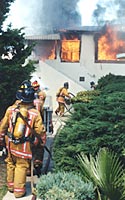Fire Suppression Terms

Like any other profession, firefighters work with their own specialized language:
Alarms
First Alarm
Specified amount of equipment and staff needed to extinguish a normal size fire or incident. For example, a First Alarm response for a house fire is four engines, one truck and two Battalion Chiefs.
Second Alarm
Fire or incident of greater magnitude than a First Alarm. Another complement of First Alarm equipment is added to the initial response.
Third Alarm
Upgrade of Second Alarm where an additional complement of First Alarm units is added along with any staff or equipment needed to support a large scale fire, medical emergency or rescue operation.
Still Alarm
Single fire unit response such as electrical short, fence fire, or wires down.
Responses
Rescue Response
Any type of response where a person is trapped and needs specialized equipment or personnel for extrication such as vehicle rescue, water rescue or cliff rescue.
Wildland Response
A Wildland is an area covered with vegetation, having minimal structures and limited access. There are three levels of Wildland Response: Wildland Low, Wildland Medium and Wildland High. The response level is determined by wind speed, the condition of the vegetation and humidity.
Canyon Rim Response
A Canyon Rim Response is used for grass fires in a canyon. A Brush Component (2 Brush Rigs, 2 Engines, 1 Water Tender and 1 Battalion Chief) is sent to the bottom and a Structure Component (3 Engines, 1 Truck and 1 Battalion Chief) is sent to the top.
High Rise Response
The San Diego Fire-Rescue Department sends a High Rise Response to any building over four stories. 4 Engines, 2 Trucks, 1 Light/Air Rig and 2 Battalion Chiefs respond to a high rise incident. All hospitals, regardless of number of stories, receive a High Rise Response due to potential evacuation.
Teams
Strike Team
Five like pieces of equipment that, with a Strike Team Leader (Battalion Chief), respond as a unit to Wildland or Structure fires. Wildland strike teams are typically made up of (Type 3) Brush Rigs while Structure Strike Teams are made up of (Type 1) Engines.
Task Force
Two or more units assigned to function together as a single unit for a special incident or purpose. May be any combination of equipment.
Airport Alerts
Airport alerts are incidents involving aircraft at the San Diego International Airport, Montgomery Field, and Brown Field.
Alert I
Aircraft approaching with minor difficulty. (Airport units will respond - notify Battalion 1).
Alert II
Aircraft approaching with major difficulty. Airport units, Rescue 4 and Battalion 1 will respond, transmit first alarm only if requested by units on the field (Rescue 1, Rescue 2, Rescue 3) or Battalion 1.
Alert III
Aircraft crash on or near the Airport - immediate emergency action required (Airport units and first alarm if on field, second alarm if in residential area).
Alert IV
Bomb threat aboard aircraft (one engine company, MAST Captain, EDT Technician, and Battalion Chief initially respond).
A Hijack situation is the unlawful seizure of an aircraft. The response to this situation is controlled by the FAA (in the air) or the FBI (on the ground).
Crashes Off Air Field
Alert V
Aircraft crash in a populated area. Automatic 2nd Alarm, with closest Crash Rig available, R4 and a paramedic.
Reduced Alert V
Aircraft crash where there is a limited hazard. On a freeway, or city street, for example, and there is NO FIRE. Automatic 1st Alarm with closest Crash Rig.
Wildland Alert V
Aircraft crash in a wildland, unpopulated area. Crash 2 Rig, Rescue 4, Water Tender, 2 Brush Rigs, Utility Rig and a Paramedic.

